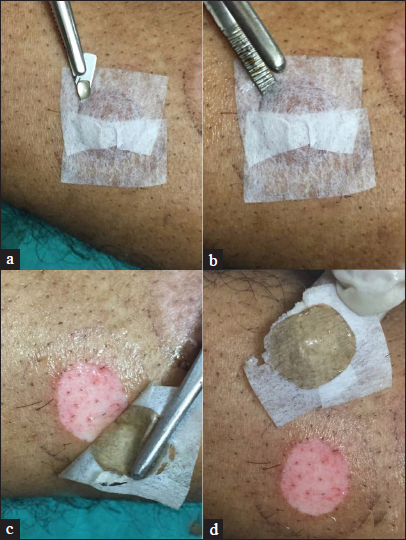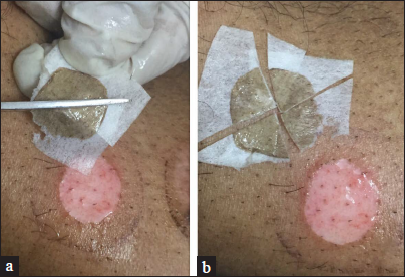Translate this page into:
Innovative techniques of splinting blister roof using micropore tape before harvesting
Corresponding author: Dr. Muhammed Mukhtar, Department of Dermatology, Mukhtar Skin Centre, Katihar-854105, Bihar, India. drmmukhtar20@gmail.com
-
Received: ,
Accepted: ,
How to cite this article: Mukhtar M. Innovative techniques of splinting blister roof using micropore tape before harvesting. Indian J Dermatol Venereol Leprol 2023;89:638–9.
Problem
A suction blister is a fluid-filled hemispherical structure. The blister roof has twice the surface area of its base (the area of a hemisphere is 2πr2, and the area of its base is πr2, where r is the radius of the blister). Because of fibrinous nature of the dermal surface of graft, the blister graft attempts to incurl and wrinkle like a deflated balloon, making it difficult to uncurl the graft after harvesting. On convex surfaces such as gloved fingers, syringe barrels and ballooned gloves, the graft is easily uncurled.1–3
As the epidermis is thin, frail and translucent, it is difficult to notice the blister surface if accidentally modified or overturned. Furthermore, if the graft is cut with scissors, it is lost on the periphery.
Solution
We employed ethylene dioxide or ultraviolet light sterilised micropore adhesive tape to address the aforementioned issues. Firstly, we patched each half of the blister with two tiny micropore adhesive tapes and then the tape was pressed with a suction syringe barrel rim at the border/margin of the blister [Figures 1a and b]. Following that, we pricked the blister or nicked at its margin with a tiny piece of the blade and gently detached the epidermis from the blister margin with blunt or flat forceps without graft loss in the margin [Figures 2a – d]. After harvesting, the graft remained in a dome-shaped, uncurled and immediately recognisable surface. Splinting the graft with tape allows it to be identified and sliced into any shape or size and easily transported to the recipient location [Figures 3a and b]. Patching or splinting the blister before harvesting the graft thereby addresses numerous surgical issues associated with blister grafting. In addition to this technique, a few customised hemispherical/circular adhesive tapes can be used for splinting the blister roof before its harvestation and transportation. The micropore tape is employed as a template rather than being removed from the graft, and the excess tape is cut off before grafting.

- The blister roof is patched with adhesive tape and the margin is pressed with a syringe barrel

- The blister is pricked and detached and its graft is harvested using blunt forceps

- The epidermal graft is resized/cut into four pieces
Declaration of patient consent
The authors certify that they have obtained all appropriate patient consent.
Financial support and sponsorship
Nil.
Conflict of interest
There are no conflicts of interest.
References
- Use of disposable syringe for transfer of graft in suction blister grafting. J Am Acad Dermatol. 2022;86:e43-44.
- [CrossRef] [PubMed] [Google Scholar]
- Ballooned glove for smooth epidermal graft transfer in vitiligo. J Am Acad Dermatol 2022 S0190-9622(22)00439-X
- [CrossRef] [PubMed] [Google Scholar]
- Surgical pearl: Gloved finger as a transport platform for epidermal graft of suction blister. J Am Acad Dermatol. 2007;57:S118-19.
- [CrossRef] [PubMed] [Google Scholar]





